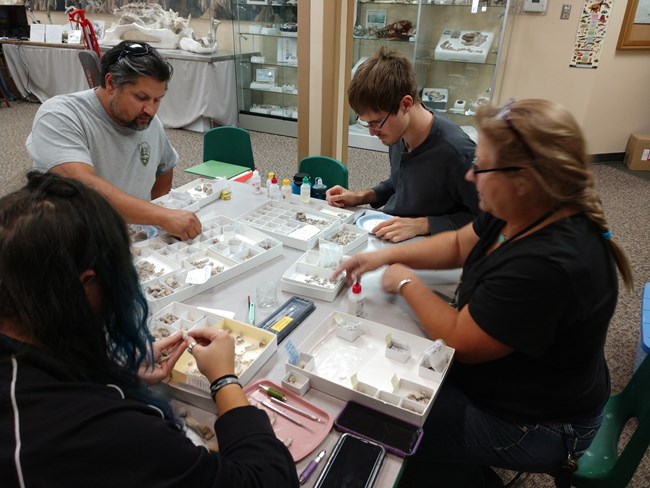Last updated: October 19, 2020
Article
Fossil Lab: Current Projects

NPS Photo / Larry McAfee

NPS Photo / Alex Carrier
Because the Fossil Preparation Lab runs from June through September, paleontologists in the Badlands have time to work on all sorts of projects. The majority of fossils found in the park and worked on by park staff are fossil mammals that roamed this area from 37-28 million years ago. Occasionally, paleontologists will work on marine fossils from older layers like the Pierre Shale, which formed while South Dakota was covered by a shallow inland sea.
So, what’s new this season? Badlands paleontologists are currently working on the following projects:
Merycoidodon
- Perchoerus probus: Geologist in Parks Intern, Jessie McCraw, discovered this fossil peccary skull while hiking in the park. The fossil was prepared for study by seasonal lab preparator Lexi Richmond. Peccaries (Family: Tyassuidae) represent a long lived lineage of pig-like animals, only known from North and South America today. You can find living peccaries, like the Javelina, in other NPS sites like Big Bend National Park, Saguaro National Park, and Organ Pipe Cactus National Monument. Peccaries, like Perchoerus, are uncommon to rare in the Badlands and represent the oldest members of the peccary family in the fossil record. Also, many specimens collected historically have very poor, incomplete, or nonexistent locality and stratigraphic information. New discoveries, like this, help clarify the progress and diversity of peccary species in the Badlands area.
- Fossil Preparators Blake Chapman and Lexi Richmond are prepping a VERY large 30 million year old tortoise (Stylemys sp.) shell (~14”Wx18”Lx12”D). Park Law Enforcement was concerned that it might be in danger of being poached, and requested it be excavated. The shell is remarkedly complete. However, typical of most specimens, weathering readily exposes and separates the bones of the animal, and these are rarely found. The completeness of this specimen suggests we MIGHT find some leg or head bones as we continue to prep this big guy!
- Fossil Preparator Mary Carpenter has been working on a nearly complete skull, and numerous other bones, belonging to an extinct saber-toothed cat-like animal called Hoplophoneus primaevus. This specimen is one of only a few nearly complete H. primaevus skulls found in the park. And this one has many more “post-cranial” (“below the skull”) bones associated with it than any other specimen we’ve found! We are very excited to see how much of the complete body we might have!
- We typically clean and conserve larger animals, as discussed above. However, during conservation of a hyracodon (an extinct rhinoceros-like animal) skull, fossil preparator Lexi Richmond found a tiny, microscopic tooth! Measuring only 1.5mm wide, this tooth belonged to a small mouse-sized extinct opossum called Herpetotherium. The last Herpetotherium fossil found in the park was in 2012! It’s a very rare and important discovery!
As park staff complete these projects, new fossils will rotate in. Stay tuned and check this page for further updates on what the lab is doing next!
